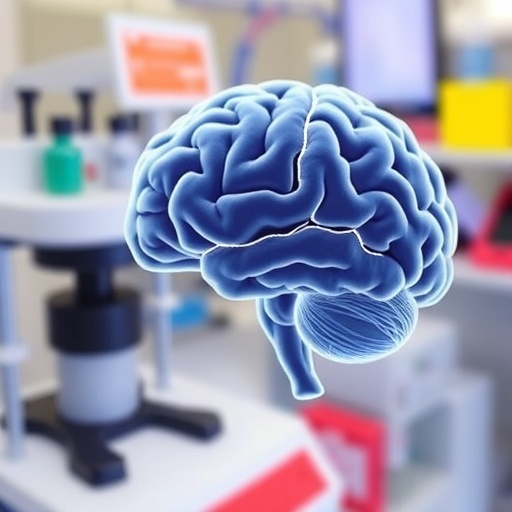A groundbreaking advancement in Alzheimer’s disease research has emerged from the Federal University of ABC (UFABC) in Brazil, where scientists have synthesized a novel chemical compound that demonstrates remarkable potential in combating this devastating neurodegenerative disorder. Alzheimer’s disease, characterized by cognitive decline and memory loss, remains a global health challenge with limited therapeutic options. This new compound, developed through a comprehensive multidisciplinary approach encompassing computational modeling, cell culture assays, and animal studies, represents a significant leap toward targeted and effective treatments that could redefine the future of Alzheimer’s care.
This research initiative, supported by the São Paulo Research Foundation (FAPESP), focuses on modulating copper homeostasis within the brain to address one of the disease’s critical biochemical hallmarks: the aggregation of beta-amyloid plaques. These plaques form from the clumping of amyloid peptide fragments between neurons, triggering neuroinflammation and disrupting synaptic communication, which are central to cognitive dysfunction. The UFABC team’s strategy leverages the emerging understanding of metal ion dysregulation—particularly copper ions—in Alzheimer’s pathology, an area that has gained traction over the past decade.
Molecularly, the compounds act as copper chelators, molecules capable of selectively binding excess copper ions embedded within beta-amyloid plaques. By sequestering these ions, the chelators promote the degradation and dissolution of these harmful aggregates. This mode of action is innovative because it targets the underlying biochemical imbalances, which previous treatments have only marginally addressed. Through in silico studies, these compounds were validated for their ability to traverse the blood-brain barrier, a formidable obstacle in CNS drug development, ensuring that therapeutic agents reach the affected brain regions effectively.
Among a series of ten newly synthesized molecules, three demonstrated notable efficacy in in vivo experiments involving rats induced with Alzheimer’s-like pathology. These animal models exhibited hallmark symptoms such as memory impairment, spatial disorientation, and altered learning capabilities, mimicking human Alzheimer’s traits. One molecule outshone others, exhibiting superior safety and therapeutic profiles, including the reversal of beta-amyloid plaque formation in the hippocampus—the region critical to memory encoding and retrieval.
Further detailed investigation revealed that the compound not only reduced neuroinflammation but also attenuated oxidative stress within hippocampal neurons, crucial both as causative and consequential factors in neurodegeneration. The restoration of copper balance in the brain’s microenvironment highlights the compound’s sophisticated mechanism, reestablishing metal homeostasis essential for normal neuronal function. Behavioral tests corroborated these biochemical outcomes as treated animals showed marked improvements in spatial memory and cognitive performance compared to controls.
Toxicological evaluations underscored the compound’s safety, showing no deleterious effects on hippocampal cell cultures or physiological parameters in treated animals throughout the experimentation period. This finding is particularly encouraging given the cytotoxic concerns associated with many investigational Alzheimer’s therapies. The research group’s integration of computational, biochemical, and behavioral data strengthens the validation pipeline, aligning with contemporary standards in drug development and translational neuroscience.
This pioneering work was led and orchestrated by Professor Giselle Cerchiaro at UFABC’s Center for Natural and Human Sciences with contributions from doctoral candidate Mariana L. M. Camargo, master’s student Giovana Bertazzo, and undergraduate researcher Augusto Farias. The collaboration extended to expert chemists at the Federal University of São Carlos (UFSCar), where Professor Kleber Thiago de Oliveira’s team synthesized key intermediates vital for the compound’s production.
The implications of this discovery transcend mere symptom management, offering a therapeutic approach potentially addressing one of Alzheimer’s primary etiological pathways. While current treatments largely mitigate symptoms or involve high-cost monoclonal antibodies targeting beta-amyloid without broad accessibility, the UFABC compound is characterized by its straightforward synthetic routes and cost-effectiveness, which could democratize Alzheimer’s care if successfully translated into clinical settings.
Despite Alzheimer’s complex pathogenesis involving genetic, environmental, and molecular factors, modulating metal ion imbalance represents a promising therapeutic angle. The UFABC researchers emphasize that while the compound may not universally cure all forms of Alzheimer’s due to the disease’s heterogeneity, its efficacy in a subset of patients aligned with metal accumulation pathways could revolutionize treatment paradigms.
The research team has already secured a patent application for the compound and is proactively exploring partnerships with pharmaceutical companies to propel the compound into the clinical trial phase. This translational endeavor is indispensable for verifying efficacy and safety in human populations and ultimately bringing a novel, affordable treatment modality to market.
As the global prevalence of Alzheimer’s disease continues to escalate—currently affecting approximately 50 million people worldwide—the urgency for innovative medicines remains paramount. The UFABC study’s combination of cutting-edge chemistry, computational biology, and rigorous in vivo validation embodies the future of neurodegenerative disease research fostering hope for millions impacted by this relentless disease.
In conclusion, this innovative approach to Alzheimer’s treatment represents a paradigm shift—targeting the biochemical roots of pathology rather than symptomatic palliation. By harnessing copper chelation to dismantle deleterious plaque formations safely and effectively, the UFABC team has laid a foundation upon which future Alzheimer’s therapies may build, promising enhanced cognitive function and quality of life for patients globally.
Subject of Research: Novel Copper Chelators for Alzheimer’s Disease Treatment
Article Title: Novel Copper Chelators Enhance Spatial Memory and Biochemical Outcomes in Alzheimer’s Disease Model
News Publication Date: 15-Aug-2025
Web References:
Swiss Federal University of ABC (UFABC) Research Page
São Paulo Research Foundation (FAPESP) Official Website: www.fapesp.br/en
Journal Article DOI: http://dx.doi.org/10.1021/acschemneuro.5c00291
References:
Camargo, M.L.M. et al. “Novel Copper Chelators Enhance Spatial Memory and Biochemical Outcomes in Alzheimer’s Disease Model.” ACS Chemical Neuroscience, 2025.
Keywords:
Alzheimer disease, Copper, Molecules, Pharmacology




